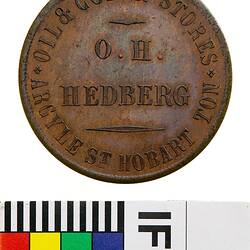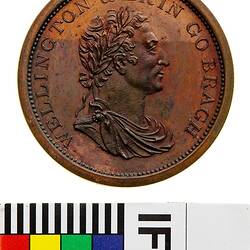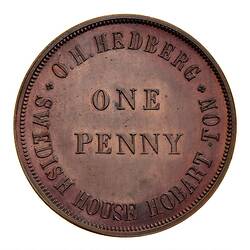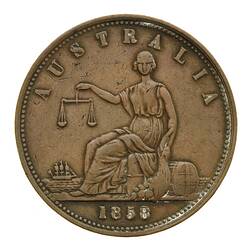Summary
Copper one Penny mule token was minted by W.J. Taylor of London. Commissioned in 1860 by Olof Hilmer Hedburg a merchant in Hobart, Tasmania. Hedburg was originally from Sweden but settled in Hobart in 1844 and became involved in the whaling industry. After the decline of the whaling industry in the mid-1850s, he opened a business as a produce merchant and commission agent in Argyle Street, Hobart, it is from this business his tokens were issued.
Hedberg's main issue was quite standard, being a penny and a halfpenny. However it is confused by the existence of a large number of patterns, mules and late strikes. The regular series of issued tokens had no pictorial element. A second group of penny token patterns offered a variety of forms of the seated Australia while the third group, provide a variety of mules in both penny and halfpenny denominations and should be considered late strikes.
Physical Description
A round copper token (34 mm diameter) featuring the name address and buisness of : O.H. Hedberg, Argyle St. Hobart Ton (sic), oil and color stores; combined with a portrait bust of Wellington with the Irish legend WELLINGTON & ERIN GO BRACH
Obverse Description
Across centre on two lines between bars, O.H. / HEDBERG around above, * OIL & COLOR STORES * around below, ARGYLE ST. HOBART TON
Reverse Description
A portrait bust of Wellington facing right, laureate and draped, around WELLINGTON & ERIN GO BRACH
Edge Description
Obverse: O.H. / HEDBERG OIL & COLOR STORES ARGYLE ST. HOBART TON Reverse: WELLINGTON & ERIN GO BRACH
More Information
-
Collecting Areas
-
Acquisition Information
Transfer from National Gallery of Victoria (NGV), 15 Mar 1976
-
Date Issued
circa 1860 AD
-
Issued By
O H Hedberg, Hobart, Greater Hobart, Tasmania, Australia, 1855-1865
-
Mint
-
Previous Collection
-
Inscriptions
Obverse: AUSTRALIA Reverse: WELLINGTON & ERIN GO BRACH
-
Denomination
-
Series
-
Material
Copper
-
Axis
06
-
Classification
-
Category
-
Discipline
-
Type of item
-
Dimensions
34 mm (Outside Diameter), 15.032 g (Weight)
-
Shape
Round
-
References
[Book] Andrews, Arthur. 1921. Australasian Tokens and Coins., no. 197 and no. 323
[Book] Heyde, Gilbert C. & Skinner, Dion H. 1967. Unofficial Coins of Colonial Australia and New Zealand.
-
Keywords





